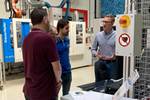TPRC research project investigates thermoplastic composite structure repair strategies
Linda Grafen’s two-year study explored reconsolidation and patch repair methods to determine their feasibility for impact damage repairing.
Linda Grafen. Photo Credit: Gijs van Ouwerkerk
In collaboration with ThermoPlastic composites Research Center (TPRC, Enschede, Netherlands) industrial partners, Linda Grafen, lead development engineer at Bosch Thermotechniek B.V. (Deventer) and project engineer at TMC (Enschede), has finalized a two-year research project, “Fixing damages of thermoplastic composite structures (FICS),” performed within the Top Technology Twente – Connecting Industry program of the (UT, Enschede). The objective of her work was to investigate thermoplastic composites repair strategies based on fusion bonding techniques, thereby exploiting the melt-processable nature of the thermoplastic matrix.
Grafen chose to focus on repairing impact damages, such as matrix transverse cracks and delaminations. During this project, she explored two different repair methods, namely reconsolidation and patch repair. She conducted a coupon-level study to understand the effect of these repair techniques on quality and mechanical performance of unidirectional (UD) carbon fiber-reinforced polyaryletherketone (C/PAEK) laminates.
The reconsolidation of impacted laminates was conducted using the vacuum-bag-only (VBO) method. Their mechanical performance was assessed via compression testing and compared to the compressive properties of impacted samples and an open-hole reference sample. It was found that the reconsolidation fully healed delaminations and matrix cracks, resulting in a recovery of the mechanical performance, as the samples outperformed the reference notched compressive strength.
The same VBO process was used to investigate the patch repair method. The mechanical performance of different patch configurations, such as scarf, step and scarf doubler, was evaluated via tensile testing and compared to the tensile properties of the reference material. Tensile properties comparable to the reference material were achieved, depending on the patch configuration.
Overall, this study demonstrates the potential of reconsolidation and patches as methods for repairing impact damages, ranging from barely visible to severe structural damages, and represents a way forward for developing melt-processable repair strategies for larger and complex thermoplastic composites structures.
Related Content
-
From the CW Archives: Airbus A400M cargo door
The inaugural CW From the Archives revisits Sara Black’s 2007 story on out-of-autoclave infusion used to fabricate the massive composite upper cargo door for the Airbus A400M military airlifter.
-
Thermoplastic composites: Cracking the horizontal body panel nut
Versatile sandwich panel technology solves decades-long exterior automotive challenge.
-
“Structured air” TPS safeguards composite structures
Powered by an 85% air/15% pure polyimide aerogel, Blueshift’s novel material system protects structures during transient thermal events from -200°C to beyond 2400°C for rockets, battery boxes and more.







